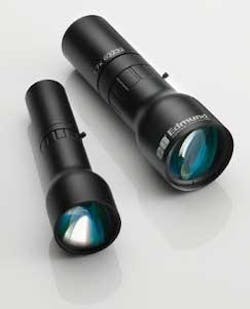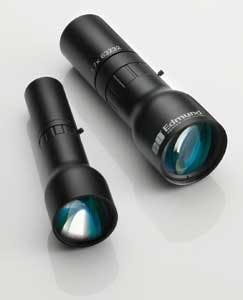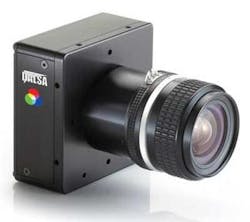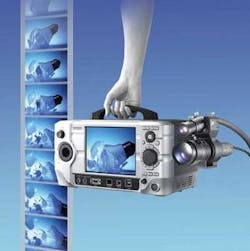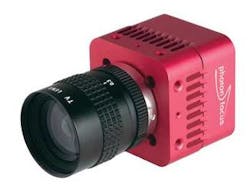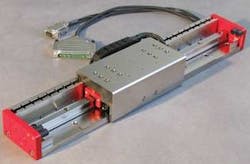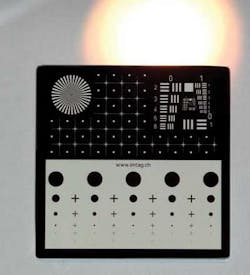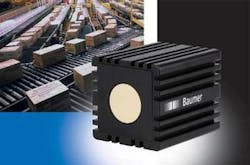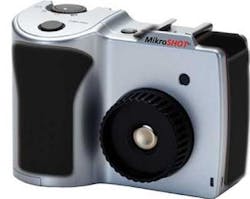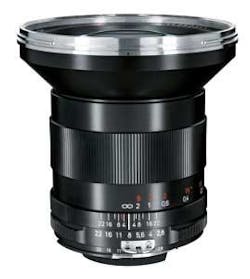Vision + Automation Products
Lenses integrate f/6 design for light collection
TECHSPEC 5-Mpixel telecentric lenses are designed with small pixels needed for use with 5-Mpixel sensors. The lenses provide up to 2/3-in. sensor coverage and integrate light-collecting f/6 designs. They offer high contrast at 72 lp/mm across the full sensor field. The lens features a locking iris and focus to prevent unintentional lens adjustments in high-vibration environments. Each lens uses an image-side telecentric design that eliminates illumination roll-off. Edmund Optics, Barrington, NJ, USA; www.edmundoptics.com
Color CMOS cameras run at 60 frames/s
The Falcon 4M60 and 4M30 color CMOS cameras are capable of running at 60 frames/s with 4-Mpixel resolution, suitable for color applications. Global shuttering eliminates imaging issues such as smearing or time displacement artifacts. Individual color gain and offset allow for white balancing of the image. Fully programmable with a Base or Medium Camera Link interface, the cameras incorporate vertical windowing, flat-field correction, exposure control, gain and offset adjustment, and antiblooming. DALSA, Waterloo, ON, Canada, www.dalsa.com/vw
Scope captures magnified high-speed video
The VW-6000 Series motion analysis microscope offers high-speed magnified video capture capabilities. Motion recording up to 24,000 frames/s enables accurate filming of failures in moving targets. A built-in light source and LCD monitor simplify and decrease setup time. The Macro Zoom Unit with built-in lighting allows flexibility of light coverage and observation at any angle. The controller supports both color and monochrome cameras. A Time Advance function allows users to record video at fixed intervals for targets that move continuously.
Keyence, Woodcliff Lake, NJ, USA, www.keyence.com/vw
NIR cameras feature dynamic range up to 120 dB
A series of near-infrared (NIR) cameras includes models MV1-D1312-40-CL, MV1-D1312I-40-CL, and MV1-D1312I-160-CL based on the newly developed third-generation A1312 and A1312I CMOS sensors. The A1312I sensor was developed for NIR applications up to 1100 nm. Sensor resolution is 1312 × 1082 pixels, with 8 × 8-µm square pixels and over 60% fill factor with high image quality. The MV1-D1312-40-CL delivers 27 frames/s, the MV1-D1312I-160-CL 110 frames/s, and the MV1-D1312(I)-40-GB 27 frames/s, all at full resolution. The units provide a dynamic range up to 120 dB with patented LinLog technology.
Photonfocus
Lachen, Switzerland
www.photonfocus.com
Actuator drives stage up to 5 m/s at 10 g
The P3 is a robust, linear motor stage designed for the automation, packaging, paper converting, and semiconductor industries with speeds up to 5 m/s at 10 g and travel lengths up to 1 m. The design features an innovative thermal handling capability with the linear motor coil integrated into the top assembly plate. This allows optimized thermal conductivity for more robust operation in extreme environments under high duty cycles. The integrated linear motor design provides high stiffness/low cogging, resulting in extremely smooth constant velocity motion at low speeds. The system offers two encoder feedback options: a magnetic encoder, which provides clean quadrature signals for difficult environments from 1- to 5-µm resolution, and an optical encoder, which provides resolution at 0.5- and 0.1-µm resolutions.
Schneeberger
Lincoln, RI, USA
www.schneeberger.com
Lasers operate at up to 20 MHz
The Z M18 range of lasers, including the Z M18-B, Z M18-S, and Z M18-H, targets complex markets. The lasers are available in red, green, blue, and infrared wavelengths with output powers up to 200 mW. They feature 5–30-VDC operation, with voltage, spike, and reverse polarity protection. At any voltage within this range, the lasers can be analog and digitally modulated simultaneously, at frequencies up to 20 MHz. This allows the laser intensity to be varied while enabling the laser to be synchronized with a camera or other equipment. Electronics include a built-in microcontroller and serial interface facilitating the logging of temperature, operating hours, and other performance characteristics. An external hand focusing mechanism, thread-mounted barrel, LED laser operation, and prefailure indicator simplify installation and maintenance.
Z-Laser Optoelektronik
Freiburg, Germany
www.z-laser.com
Calibration targets reduce unwanted reflections
Unwanted reflections from the surface of a calibration target cause problems in many optical calibration configurations. A method to reduce unwanted reflections is to use a calibration target with a white scattering surface. Due to light scattering caused by the surface roughness, no direct reflections occur. As an alternative to costly substrates such as ceramic, a cost-effective method for the manufacture of the scattering surface has been developed. Cost reduction is primarily achieved by applying a white surface on standard glass substrates. The scattering surface shows a uniform light distribution (quasi Lambertian scatter shape). The combination of a high-end patterning process for metal layers and the quality of the white surface produce an optical calibration target with good edge acuity and high pitch accuracy. Typical applications are 2-D calibration, reference marking of large objects, and photogrammetry.
IMT Masken und Teilungen
Greifensee, Switzerland
www.imtag.ch
Camera designed to replace multiple camera systems
For robotic guidance and material handling/logistics systems, the new TZG01 digital 3-D cameras are designed to replace multiple camera systems and extend the potential of 3-D object detection. The cameras’ integrated time-of-flight (ToF) sensor enables rapid spatial capture of objects and components. Data on target dimensions and position are provided with a single snapshot that captures and displays both a distance and a grayscale image. At up to 54 frames/s, the cameras offer an acquisition range of 0.3 to 5 m. Lens, sensor, and LED are integrated into an IP67-rated housing suitable for use in harsh environments exposed to moisture and particulates. A generic programming interface, Baumer-GAPI, facilitates the camera’s integration into an application. The Baumer SDK includes all libraries, help files, and tools for camera control. Standard fast Ethernet delivers data on cables up to 100 m. The camera also offers a single-cable Power over Ethernet (PoE) interface.
Baumer
Southington, CT, USA
www.baumergroup.com/cameras
Embedded system eliminates need for add-in acquisition hardware
The Matrox 4Sight XB is an industrial and medical imaging platform and the latest addition to the 4Sight family of embedded systems. It is powered by an Intel Core2 Duo processor. Support for full-height, half-length PCIe boards gives developers a choice of standard Matrox Imaging frame grabbers as well as third-party standard add-in cards for I/O and more. With integrated support for image-acquisition technologies such as GigE Vision and IEEE-1394b IIDC, the system eliminates the need for add-in acquisition boards. It runs on Windows XP Professional for embedded systems, enabling the straightforward use of device drivers for third-party add-in cards. Applications are programmed with the Matrox Imaging Library (MIL).
Matrox Imaging
Montreal, QC, Canada
www.matrox.com/imaging
Lenses come in 12.5–35 mm focal lengths
The JC5M series 5-Mpixel camera lenses are engineered for applications that monitor critical details, such as industrial factory automation, machine vision, and surveillance systems. Four JC5M lenses are available: the 12.5-mm LM12JC5M, 16-mm LM16JC5M, 25-mm LM25JC5M, and 35-mm LM35JC5M. The C-mount lenses are manually adjusted, giving the user complete control over focus and iris settings. The lenses minimize image distortion (between 0.01–0.06%). Each lens incorporates a proprietary floating mechanism design, which enables it to achieve optimum optical performance at various objective distances. The resolution of the lenses has been increased to 160 lp/mm at both the center and corner, allowing for high corner brightness and contrast.
Kowa Optimed
Los Angeles, CA, USA
www.kowa-usa.com
Cameras available with two Camera Link interfaces
The C3 Compact series 1.4-Mpixel cameras include CM-141MCL/CM-141PMCL (monochrome sensor) and CB-141MCL/CB-141PMCL (Bayer color sensor), which feature a >58 dB signal-to-noise ratio, 30-frames/s operation, and small size. They are designed around Sony’s ICX285 2/3-in. progressive-scan CCD (1392 × 1040 pixels), with a 6.45-μm pixel size and improved microlens technology to provide sensitivity as low as 0.03 lux with low smear. Extended spectral response is achieved in the NIR region, offering roughly four times the sensitivity of conventional sensors at a 945-nm wavelength. Reset continuous triggering (RCT) enables the camera to operate in continuous mode while awaiting a trigger signal. Other features includes preset shutter speeds up to 1/10,000 s and programmable exposures as short as 63 µs. The cameras are available with Mini Camera Link interface and PoCL (Power over Mini Camera Link), utilizing the Mini Camera Link connector.
JAI
Copenhagen, Denmark
www.jai.com
Thermal imager displays radiometric data on image
The MikroSHOT thermal imaging camera’s Thermal-on-Visible mode allows for radiometric temperature data to be displayed directly on the visible image. The lightweight (10.5 oz.) device uses off-the-shelf batteries (AC adapter also included) and features a 2.7-in. display and 160 × 120-pixel image resolution. It has a measuring range of -4° to +662°F (-20° to +350°C), operating temperature range of +5° to +122°F (-15° to +50°C), color alarm, and autofocus at distances from 1.4 yards (1.3 m) to infinity. The SD card, USB, and video output capability allow quick analysis of JPEG-format data on a laptop or other mobile device using common software. MikroSpec 4.0 software is included for image analysis and reporting.
LumaSense Technologies
Santa Clara, CA, USA
www.lumasenseinc.com
Lens corrects chromatic aberrations in low light conditions
With its chromatic aberration correction, the Distagon T* 2,8/21 ZF lens for industrial image processing gives results without color fringes even in difficult light conditions in production halls. The lens performance is supported by the T* coating and optimum flare suppression. The shortest distance setting of 0.22 m is appropriate for near-range photogrammetry or optical measurement of components. The Distagon T* 2.8/21 ZF offers low-distortion, sharp images from infinity up to the near range.
Carl Zeiss
Camera Lens Division
Oberkochen, Germany
www.zeiss.com/photo
Smart cameras use integrated image-processing software
EyeSpector smart cameras are equipped with a computing power of up to 8000 MIPS. The cameras cover resolutions ranging from 640 × 80 up to 1600 × 1200 pixels for capturing grayscale images with CCD sensors, as well as resolutions for color and rates up to 250 frames/s. The software runs under standard Windows XP, Vista, and Linux systems. EyeVision image-processing software is integrated with the cameras. Control processes can be performed quickly using the drag-and-drop function without any programming language skills. Image-processing tasks are programmed using a simple GUI.
NET
Finning, Germany
www.net-gmbh.com
